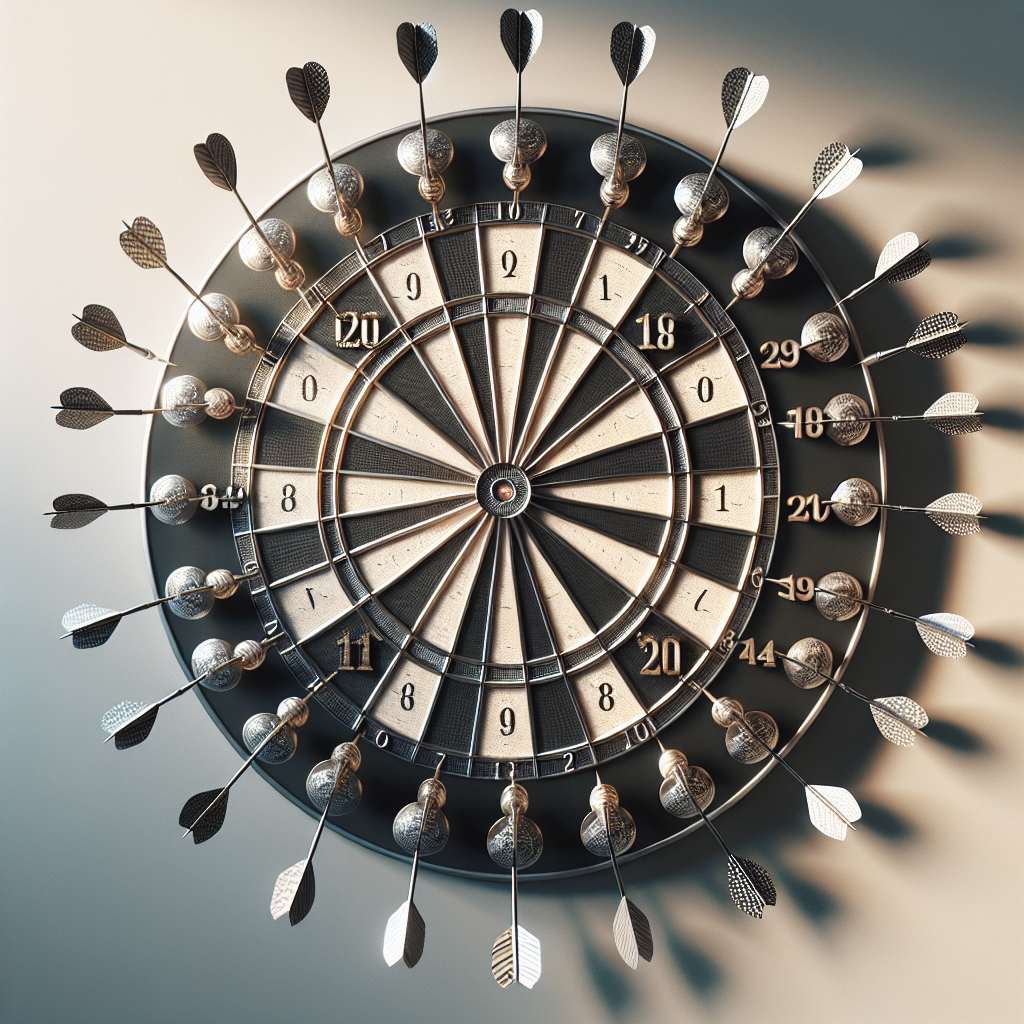Introduction to Dart Games
Dart games have been enjoyed by adults for many years as a recreational activity that combines skill and competition. Understanding the basics of dart games is essential for anyone looking to step up to the oche and start throwing some darts.
Understanding Dart Game Basics
One popular dart game that has gained significant popularity is the Around the Clock (ATC) Game. This game is often recommended for beginners due to its simple method of play and is also enjoyed by more experienced players. It can be played by one or more players and provides an excellent opportunity to practice and improve dart throwing skills.
In the Around the Clock (ATC) Game, the objective is to hit the numbers on the dartboard in sequential order, starting from 1 and working up to 20, and optionally finishing with the bullseye segment. Players take turns throwing three darts, aiming to hit the number corresponding to the current round. The winner is the first player to complete the sequence from 1 to 20, or 1 to 20 and the bullseye.
To make the game more challenging, players can incorporate additional rules. For example, hitting a double of the required number allows players to skip the next number, while hitting a treble enables them to move past two numbers. A perfect round, where all required segments are hit with each of the three darts, can reward players with another turn and the opportunity to skip ahead in the sequence (Darts Corner).
While Around the Clock (ATC) provides a great introduction to dart games, there are numerous other popular dart game variants to explore. Some of these include Cricket, 301, Baseball, and many more. Each game has its own set of rules and objectives, adding variety and excitement to the world of darts.
To learn more about different dart games and their rules, be sure to check out our articles on popular dart games and dart game rules. Whether you’re playing at home, in a bar, or even in an arcade, there’s a dart game to suit every level of skill and interest. So gather your darts, step up to the line, and start enjoying the thrilling world of dart games.
Around the Clock (ATC) Game
The “Around the Clock” (ATC) game is a popular dart game that tests both skill and strategy. In this section, we will explore the rules and objective of the game, as well as how to play it solo and customize it to add some variety.
Rules and Objective
The objective of the Around the Clock game is simple: players must successfully hit every segment from 1 to 20 on the dartboard, finishing with the 25 and bullseye. Doubles and trebles are ignored in this game (Masters of Games). The first player to hit all the targets and finish with the bullseye wins.
To play the game, players take turns throwing three darts each. They must start by hitting the number 1 and then progress in numerical order, hitting each subsequent number before moving on to the next. The order of the numbers is as follows: 1, 2, 3, and so on, up to 20. Finally, the players must hit the 25 and bullseye to complete the game.
Playing Around the Clock Solo
One of the great aspects of the Around the Clock game is that it can be played by one or more people, making it suitable for solo practice, warm-up games, or groups of two or more players (GLD Products). When playing solo, the rules remain the same. The player aims to hit each number in order, starting with 1 and ending with the bullseye. The challenge is to complete the game in as few rounds as possible, testing your accuracy and skill.
Customizing Around the Clock
To add a twist to the classic game, you can customize Around the Clock in a few different ways. Here are a couple of ideas to make the game more interesting:
-
Timed Challenge: Set a time limit for completing the game. For example, you can challenge yourself to finish Around the Clock within a certain number of minutes or seconds. This adds an element of speed and pressure to the game, testing your ability to hit each target quickly and accurately.
-
Reverse Order: Instead of starting with the number 1, begin with the highest number on the dartboard, which is 20, and work your way backward to 1. This variation adds a different strategic element to the game, requiring you to adapt your throwing technique and focus on hitting the targets in reverse order.
Remember, the goal is to have fun and improve your dart skills while playing Around the Clock. Feel free to get creative and come up with your own customizations to keep the game exciting and challenging.
In the next section, we will explore some variations of the Around the Clock game that you can try to spice up your dart-playing experience.
Variations of Around the Clock
The classic game of Around the Clock can be customized and adapted in various ways, adding new challenges and excitement to the gameplay. Here are three popular variations of Around the Clock:
180 Around the Clock
In the 180 Around the Clock variation, players aim to hit the triple section of each number, starting from 1 and progressing all the way to 20. The objective is to score a maximum of 180 points by hitting the triple 20 on each turn. This variation requires precision and accuracy, as hitting the triple section consistently can be quite challenging. It is a great way to test and improve your aiming skills.
Quickly Around the World
In the Quickly Around the World variant, hitting the double section of a number allows the player to skip the next number. Furthermore, hitting the triple section of a number results in skipping two numbers. This variation adds a reward stimulus to the game, encouraging players to aim for the double and triple sections to progress through the numbers more quickly. It adds an extra layer of strategy and excitement to the gameplay.
Michael van Gerwen’s Strategy
World number one darts player, Michael van Gerwen, has his own unique strategy for playing Around the Clock. He incorporates a reward system into the game, where he skips fields if he was successful on the previous field or even exceeded expectations. This strategy helps in optimizing gameplay and skill development. By challenging himself and setting higher goals, van Gerwen pushes the boundaries of his own abilities. You can adopt a similar approach to continuously improve your skills and make the game more engaging.
By exploring these variations of Around the Clock, you can add new dimensions to your dart game and keep the excitement alive. Whether you choose to aim for the triple sections, implement skip rules, or adopt a reward system like Michael van Gerwen, these variations provide opportunities to enhance your skills and have fun while playing. Remember to always adapt the game to your preferences and enjoy the journey of becoming a better darts player.
Popular Dart Game Variants
Darts is a versatile game with numerous variants that cater to different skill levels and preferences. In this section, we will explore four popular dart game variants: Legs Game, Killer Game, Halve-It Game, and Shanghai Game.
Legs Game
The Legs Game, also known as 301 or 501, is one of the most popular dart game variants played both casually and professionally. The objective of the game is to reach zero points by subtracting the score achieved with each throw from the starting total of 301 or 501. Players take turns throwing three darts each, aiming to score as many points as possible with each throw.
To learn more about the rules and strategies involved in the Legs Game, refer to our article on 301 dart game rules.
Killer Game
The Killer Game is an exciting and fast-paced dart game that requires players to hit doubles only. Each player chooses a random number by shooting at the board with their non-shooting hand. The chosen number becomes their target. The objective of the game is to hit the target number’s double while avoiding hitting any other doubles. Players accumulate points based on the doubles they hit.
The Killer Game is particularly enjoyable when played with friends, and there is even a variation called the balloon dart game that adds an extra layer of excitement. For more detailed rules and variations, check out our article on dart games rules.
Halve-It Game
The Halve-It Game is a fun and challenging dart game suitable for players of all skill levels. The game involves a series of target numbers and a penalty for missing the target. Each player takes turns throwing three darts at the board, aiming to hit the designated target numbers. If a player hits the target number, they earn points. However, if they miss the target, their score is halved.
The Halve-It Game can be played with any number of players, making it a versatile option for different group sizes. Each player gets three turns to throw darts and accumulate points. To learn more about the specific rules and strategies for the Halve-It Game, refer to our article on halve-it dart game rules.
Shanghai Game
The Shanghai Game is an entertaining dart game that is ideal for large groups of players. The game derives its name from the dart term “Shanghai,” which refers to hitting a single, double, and triple of the same number in one turn. In the Shanghai Game, players take turns throwing darts at a predetermined set of numbers, ranging from 1 to 7. Each inning corresponds to a specific number, and the objective is to hit a single, double, and triple of that number in a single turn.
The Shanghai Game can be played with any number of participants and provides a lively and competitive atmosphere. To discover more about the rules and strategies of the Shanghai Game, refer to our article on shanghai dart game rules.
By exploring these popular dart game variants, you can add variety and excitement to your dart playing experience. Whether you prefer the strategic challenge of the Legs Game, the intensity of the Killer Game, the skill-testing nature of the Halve-It Game, or the group dynamics of the Shanghai Game, there is a dart game variant to suit your preferences and skill level.
Improving Dart Skills
To become a proficient dart player, it’s essential to continuously work on improving your skills. Whether you’re a beginner or an experienced player, there are various techniques and tips that can help enhance your dart game. In this section, we will explore solo practice techniques and provide tips for enhancing accuracy.
Solo Practice Techniques
Practicing darts alone can still be enjoyable and beneficial for improving your game. Here are a few solo practice techniques you can try:
-
Round the Clock: A popular solo practice game is the “Round the Clock” game. In this game, you aim to hit each number on the dartboard in order, starting from 1 and progressing clockwise to 20. Score yourself based on the number of darts it takes to hit each number. To make it more challenging, require hits on the single, double, and triple ring of each number before moving on. This game helps improve your accuracy and consistency.
-
301 Game: Another solo practice method is to play games like 301, where the objective is to reach zero points using as few darts as possible. This game helps you focus on finishing quickly and can improve your overall accuracy and scoring ability.
-
Shanghai: Playing Shanghai is another solo practice technique that can help improve your aim. The game involves shooting for a new target on the board every turn, such as hitting the single, double, and triple of a specific number. This game challenges your accuracy and helps you become more proficient in hitting different areas of the dartboard.
Remember to use a standard dartboard and quality darts for your practice sessions. Consistency is key, so aim to practice regularly rather than sporadically. Short, focused practice sessions that emphasize muscle memory and accuracy are more beneficial than lengthy sessions. For more information on different types of dart games, check out our article on popular dart games.
Tips for Enhancing Accuracy
Improving your accuracy is crucial for success in dart games. Here are some tips to help you enhance your accuracy:
-
Focus on the Target: Concentrate on the specific target you want to hit on the dartboard. Visualize your dart hitting the desired area before throwing. Maintaining focus on the target helps improve your aim and precision.
-
Stance and Grip: Establish a stable and comfortable stance while throwing darts. Find a grip that feels natural to you and provides control over the dart. Experiment with different grips and stances to discover what works best for you.
-
Follow Through: Ensure a smooth and consistent follow-through after releasing the dart. Allow your arm to extend naturally towards the target. This follow-through motion helps in maintaining accuracy and control.
-
Practice with Targets: Set up targets on the dartboard to improve your aim. For example, aim for specific segments or sections of the dartboard, such as hitting the triple 20 consistently. This targeted practice helps build muscle memory and improves your ability to hit specific areas.
-
Analyze and Adjust: Pay attention to your throw and analyze your results. If you consistently miss in a certain direction, make adjustments to your aim, stance, or grip. Experiment with different techniques to find what works best for you.
By implementing these solo practice techniques and incorporating tips for accuracy, you can steadily improve your dart skills over time. Remember to practice regularly, stay focused, and enjoy the process of honing your dart-playing abilities.
Fun Facts and Records
Dart games are not only a source of entertainment but also a platform for players to showcase their skills and set impressive records. In this section, we’ll explore some of the fascinating records and achievements in the world of darts.
World Record for Fastest Round
The world record for the fastest round of the Around the Clock (ATC) dart game was achieved by Llew Bevan from the UK in Crymych, Wales on February 21, 2021. Bevan completed the game in an astonishing time of 1 minute and 19.79 seconds, showcasing his exceptional speed and accuracy (LinkedIn).
Notable Dart Game Records
Aside from the world record for the fastest round of Around the Clock, there are various other notable records in the realm of dart games. These records showcase the incredible talent and precision of dart players worldwide.
It’s important to note that records can vary depending on the specific game variant being played. For example, in the popular Cricket dart game, players aim to close out specific numbers and score points. In 301 or 501 games, the objective is to reach zero points from a starting score.
While specific records can change over time, it’s worth mentioning that the sport of darts has seen remarkable achievements in terms of high scores, perfect finishes, and impressive averages. These records continue to inspire and motivate players to push the boundaries of their skills.
As you explore the world of dart games, keep an eye out for new records being set and the incredible feats accomplished by talented players. The pursuit of excellence and the drive to continuously improve are what make the sport of darts so captivating.
For more information on popular dart game variants and rules, check out our article on popular dart games. Whether you’re playing for fun or aiming to break records, dart games offer a thrilling and competitive experience for players of all levels.







